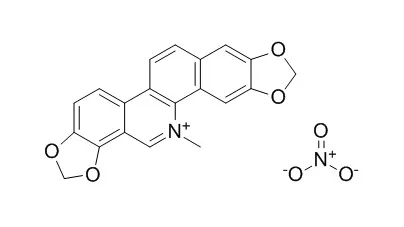| In vitro: |
| Journal of biological chemistry, 1986, 261(5):2034. | | Biochemical and cross-resistance studies with HeLa cell mutants resistant to cardiac glycoside SC4453. Regulation of the resistant form of Na+/K+-ATPase in the mutant cells.[Reference: WebLink] | In HeLa cells, stable mutants which are between 25-to about 200-fold resistant to the cardiac glycoside derivative SC4453 (a digoxin analog which contains a pyridazine ring in place of a lactone ring in the C-17 position) have been isolated after a single step selection in the presence of the drug.
METHODS AND RESULTS:
Based on their cross-resistance pattern towards various cardiac glycosides, the mutants resistant to SC4453 (SCR mutants) appear to be of two different kinds and they differ from the two classes of ouabain-resistant mutants described previously (Gupta, R. S., and Chopra, A. (1985) J. Biol. Chem. 260, 6843-6850). One type of SCR mutants (designated as group C) exhibit a high degree of cross-resistance to all cardiac glycosides and their genins (viz. ouabain, digitoxin, digoxin, digoxigenin, convallatoxin, gitoxin, strophanthidin, and bufalin). In contrast, the second type of SCR mutant (group D) exhibit considerable resistance to only SC4453, digoxin, and digoxigenin, but showed very little or no cross-resistance to the other cardiac glycosides examined. The cross-resistance of the mutants towards cardiac glycosides was highly specific as they exhibited no cross-resistance towards a large number of other structurally and functionally related compounds (viz. ethacrynic acid, Sanguinarine nitrate, penicillic acid, methyl quinolizinum bromide, 5,5'-diphenylhydantoin, deoxycorticosterone, vanadium pentoxide, and adriamycin). The cellular uptake of 86Rb in the mutant cells was found to be resistant to specific cardiac glycosides. Studies on the sensitivity of plasma membrane Na+/K+-ATPase to cardiac glycosides show that about 10-15% of the enzymic activity in the mutant cells was highly resistant to inhibition by the specific drugs to which the mutants exhibit increased resistance. Very interestingly, when the mutant cells are grown in cardiac glycoside-containing medium, the resistant form of the enzyme accounts for about 50-60% of the total enzyme.
CONCLUSIONS:
These results show that both classes of SCR mutants are affected in Na+/K+-ATPase and that the amount of the resistant enzyme in the mutant cells is regulated in response to cardiac glycosides. | | Postępy fitoterapii, 2012. | | The effect of alkaloids and other groups of plant compounds on bacteria and fungi.[Reference: WebLink] | The studies included 35 substances belonging to alkaloids, coumarins, quinones, polyacetylenes, saponines and other chemical groups.
METHODS AND RESULTS:
It was documented that the strongest antibacterial activity on Gram-positive bacteria showed; shikonine and her derivates, berberine chloride, Sanguinarine nitrate, falkarionol, digitonine and usnic acid. The Sanguinarine nitrate and digitonine showed strong activity on Gram-negative bacteria. Imperatorine, Sanguinarine nitrate, sempervirine, galantamine hydrobromide, falkarinol, alantolactone and aristolochic acid showed the strong activity against yeast fungi and dermatophytes.
CONCLUSIONS:
The mentioned substances inhibited the growth of bacteria in concentration limits 1-250 μg/ml. The conducted studies show the possibility of the use some plant substances in medical practice. |
|






 Cell. 2018 Jan 11;172(1-2):249-261.e12. doi: 10.1016/j.cell.2017.12.019.IF=36.216(2019)
Cell. 2018 Jan 11;172(1-2):249-261.e12. doi: 10.1016/j.cell.2017.12.019.IF=36.216(2019) Cell Metab. 2020 Mar 3;31(3):534-548.e5. doi: 10.1016/j.cmet.2020.01.002.IF=22.415(2019)
Cell Metab. 2020 Mar 3;31(3):534-548.e5. doi: 10.1016/j.cmet.2020.01.002.IF=22.415(2019) Mol Cell. 2017 Nov 16;68(4):673-685.e6. doi: 10.1016/j.molcel.2017.10.022.IF=14.548(2019)
Mol Cell. 2017 Nov 16;68(4):673-685.e6. doi: 10.1016/j.molcel.2017.10.022.IF=14.548(2019)